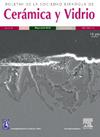用于还原聚合的羟基磷灰石- pegda浆料的优化:3D打印生物支架的微观结构和力学性能
IF 2.7
4区 材料科学
Q1 MATERIALS SCIENCE, CERAMICS
Boletin de la Sociedad Espanola de Ceramica y Vidrio
Pub Date : 2025-08-23
DOI:10.1016/j.bsecv.2025.100459
引用次数: 0
摘要
还原聚合已被用于制备多孔聚乙二醇二丙烯酸酯(PEGDA)/羟基磷灰石(HA)复合生物支架和具有可控几何形状的陶瓷羟基磷灰石生物支架,用于骨组织再生。紫外光固化浆料采用从牛骨中提取的双峰透明质酸粉配制。双峰粒度分布增强了粉末的堆积密度和机械性能,确保了有效的烧结。加入酒黄石(0.14 wt%)作为光吸收剂,以提高几何精度和复杂生物支架结构的可打印性。流变学分析显示粘度依赖于固体含量,50%的HA提供优越的分散稳定性。在1250℃下烧结有利于致密化,获得最高的抗压强度(G50样品为4.7 MPa)和最高的孔隙率(G30样品为89%)。值得注意的是,研究了烧结和非烧结样品的机械性能,揭示了可比的结果,从而证明了所开发材料和工艺的稳健性。本文章由计算机程序翻译,如有差异,请以英文原文为准。
Optimization of hydroxyapatite-PEGDA slurry for vat polymerization: Microstructure and mechanical properties of 3D printed bioscaffolds
Vat polymerization has been employed to fabricate porous poly(ethylene glycol) diacrylate (PEGDA)/hydroxyapatite (HA) composite bioscaffolds and ceramic HA bioscaffolds with controlled geometry for bone tissue regeneration. UV-curable slurries were formulated using bimodal HA powder derived from bovine bones. A bimodal particle size distribution enhanced powder packing density and mechanical properties, ensuring effective sintering. Tartrazine (0.14 wt%) was incorporated as a photoabsorber to improve geometrical accuracy and the printability of complex bioscaffold architectures. Rheological analysis revealed viscosity dependence on solid content, with 50 wt% HA providing superior dispersion stability. Sintering at 1250 °C facilitated densification, achieving the highest compressive strength (4.7 MPa for G50 samples) and exhibiting the highest porosity (89% for G30 samples). Notably, the mechanical properties of both sintered and non-sintered samples were examined, revealing comparable results, thereby demonstrating the robustness of the developed materials and processes.
求助全文
通过发布文献求助,成功后即可免费获取论文全文。
去求助
来源期刊

Boletin de la Sociedad Espanola de Ceramica y Vidrio
工程技术-材料科学:硅酸盐
CiteScore
5.50
自引率
2.90%
发文量
72
审稿时长
103 days
期刊介绍:
The Journal of the Spanish Ceramic and Glass Society publishes scientific articles and communications describing original research and reviews relating to ceramic materials and glasses. The main interests are on novel generic science and technology establishing the relationships between synthesis, processing microstructure and properties of materials. Papers may deal with ceramics and glasses included in any of the conventional categories: structural, functional, traditional, composites and cultural heritage. The main objective of the Journal of the Spanish Ceramic and Glass Society is to sustain a high standard research quality by means of appropriate reviewing procedures.
 求助内容:
求助内容: 应助结果提醒方式:
应助结果提醒方式:


